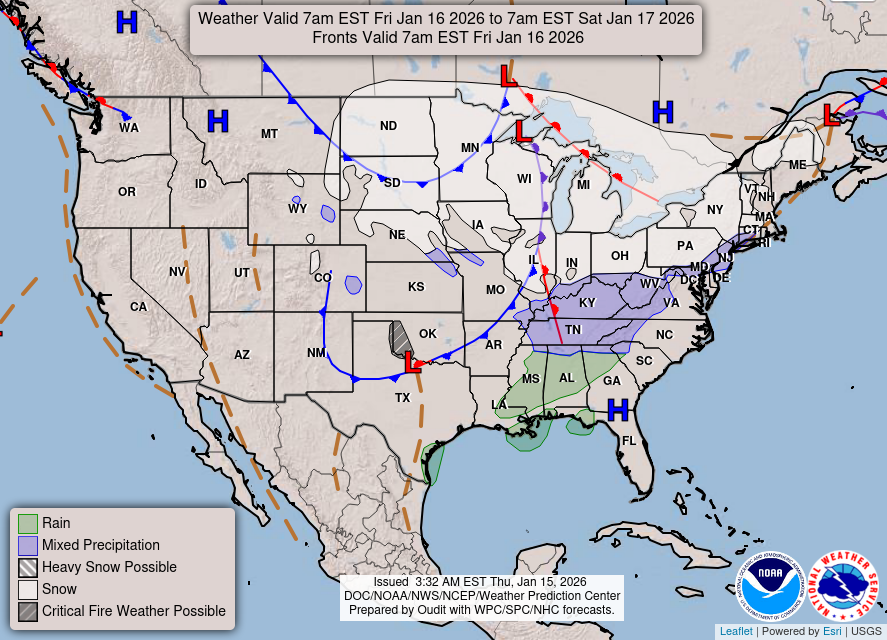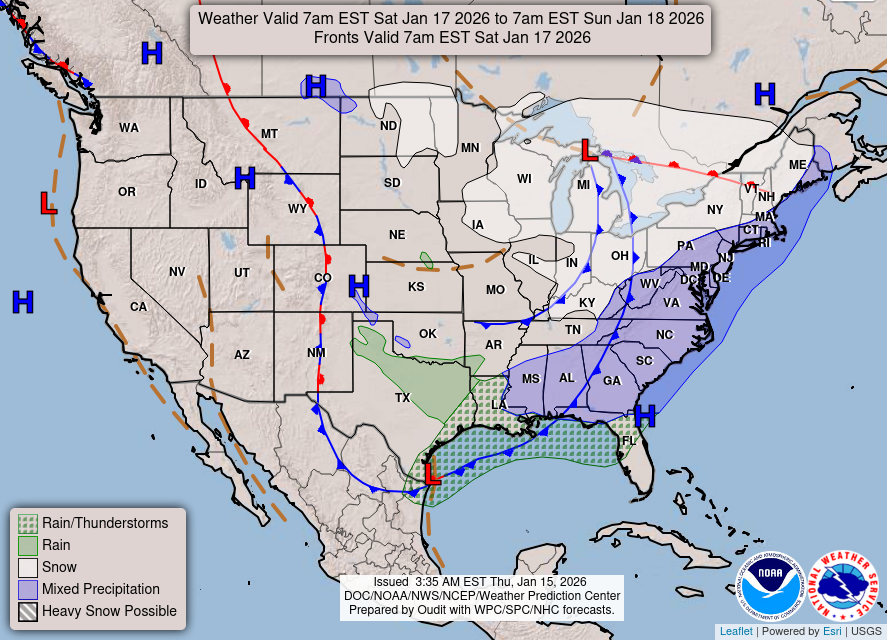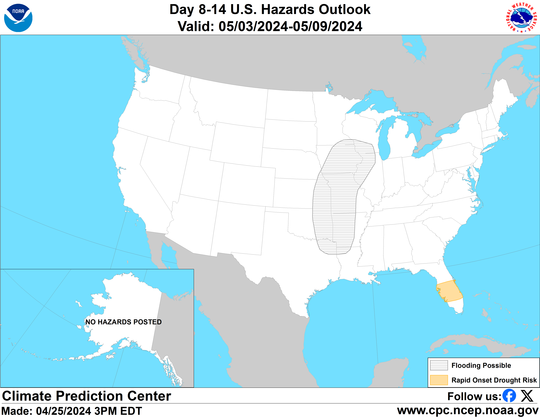This article focuses on what we are paying attention to in the next 48 to 72 hours. The article also includes weather maps for longer-term U.S. outlooks (up to four weeks) and a six-day World weather outlook which can be very useful for travelers.
First the NWS Short Range Forecast. The afternoon NWS text update can be found here after about 4 p.m. New York time but it is unlikely to have changed very much from the morning update. The images in this article automatically update.
Short Range Forecast Discussion
NWS Weather Prediction Center College Park MD
Thu Nov 14 2024
Valid 12Z Thu Nov 14 2024 – 12Z Sat Nov 16 2024…A rapidly developing coastal storm is expected to bring a period of
gusty winds, enhanced rainfall and thunderstorms from the Carolinas to the
Mid-Atlantic states Thursday night into Friday……Lower elevation/coastal rain and mountain snow continue for the Pacific
Northwest Thursday; a rain/snow mix will spread inland across the Great
Basin and Rockies Thursday and Friday……Most of the country will see seasonable to above average temperatures
to end the week…Showers will continue this morning and into Thursday afternoon ahead of a
low pressure/frontal system pushing through the Great Lakes region, with
precipitation chances gradually winding down with time and eastward extent
Thursday evening as the system weakens. To the south, more vigorous
showers and thunderstorms and heavier rainfall will continue ahead of the
front over the Upper Ohio/Tennessee Valleys and into the Southeast,
spreading into the central/southern Appalachians Thursday afternoon. Then,
by Thursday evening, a secondary low is expected to develop along the
coast of the Carolinas and deepen as it moves offshore, helping to enhance
onshore flow and rain chances over the Carolinas and southern Mid-Atlantic
into Thursday night. Some gusty winds will also be possible. Rain chances
should quickly taper off from west to east by Friday morning as the low
moves away from the coast. Further north, an area of low pressure lifting
northward over the Atlantic and into Nova Scotia will bring some showers
and possibly a wintry mix into Maine on Friday.A Pacific frontal system moving through the West will spread precipitation
chances inland over the next couple of days. Lower elevation/coastal rain
and higher elevation snowfall over the Pacific Northwest and northern
California will continue through the day Thursday before tapering off into
Thursday evening as moist flow from the Pacific comes to an end. A lower
elevation rain/snow mix and higher elevation snow will spread further
inland with the system over the northern Rockies/Great Basin Thursday and
into the central Great Basin/Rockies on Friday. Some moderate to locally
heavy snowfall is also forecast for the Sierra Nevada through Friday.Most of the country will see seasonable to above average temperatures
Thursday and Friday. Central portions of the country will continue to see
temperatures 5-15 degrees above average as an upper-level ridge passes
over the region. Forecast highs generally range from the 40s and 50s for
the Great Lakes/Midwest, the 50s for the northern Plains, the 60s for the
central Plains, and the 60s and 70s for the southern Plains. Highs will be
more seasonable and even a bit below average for the East Coast Thursday,
with 40s and 50s for New England, the Mid-Atlantic, and the Carolinas.
Temperatures will rebound a bit Friday as conditions moderate, with highs
5-10 degrees warmer and into the 50s and 60s. Areas of the Southeast/Gulf
Coast ahead of the cold front will see highs as warm as the upper 70s
Thursday before falling into the 60s and low 70s following the frontal
passage on Friday. Most of the inland West will see seasonable to above
average highs Thursday ahead of the incoming frontal system, with highs in
the 50s for the Great Basin/Rockies/Four Corners region and the 80s into
the Desert Southwest. Highs on Friday will drop into the 40s for the Great
Basin and 60s to low 70s for the Desert Southwest following the frontal
passage. The West Coast will see highs mainly in the 50s and 60s.
To get your local forecast plus active alerts and warnings click HERE and enter your city, state or zip code.
Learn about wave patterns HERE.
Then, looking at the world and of course, the U.S. shows here also. Today we are looking at precipitation.
Please click on “Read More” below to access the full Daily Report issued today.
| Notices: What would you like to learn about? Please provide that to me via the comment section at the end of the article. |
Now more detail on the 48-Hour Forecast (It is a 48 to 72 Hour Forecast actually)
Daily weather maps. The Day 1 map updates twice a day and the Day 2 and 3 maps update only once a day. These maps update automatically. But if that does not happen, you can get updates by clicking HERE
TODAY (or late in the day the evening/overnight map will appear) (Key to surface fronts shown on maps and you will then also be able to insert a city name or zip code and get a local NWS forecast).

TOMORROW

NEXT DAY

We have a new animation of the forecast which shows how things may play out over the next 60 hours. To update click ANIMATION. Doing so will get you to the dashboard. You can then step through the animation or hit LOOP on the upper right of the display. You will have to hit the back arrow ← at the top left on your computer to get back into this article. It is a little more trouble than before but I think NOAA scrapped the animation routine I was using so we have to keep up with “progress”.
The NWS Climate Prediction Center’s: Watches, Warnings, and Advisories plus other information can be found HERE. That takes you to the NWC Severe Weather Site. From there you can select among many categories of information. Remember to hit the back arrow ← at the top left of your screen to return to this article.
ATMOSPHERIC RIVERS
This tells us what is approaching the West Coast. Click HERE to update If I have not gotten around to doing the update. Here is some useful information about Atmospheric Rivers.

Below is the current five-day cumulative forecast of precipitation (Updates can be found HERE)

Ski SnowReports will Resume in the Fall.
Now we look at Intermediate-Term “Outlook” maps for three time periods. Days 6 – 10, Days 8 – 14, and Weeks 3 and 4. An outlook differs from a forecast based on how NOAA uses these terms in that an “outlook” presents information as deviation from normal and the likelihood of these deviations.
Below are the links to obtain updates and additional information. They are particularly useful if you happen to be reading this article significantly later than when it was published. I always try to provide readers with the source of the information in my articles. These links may also be useful for those viewing this article on a cell phone or other small screen.
| Days 6 – 10 (shown in Row 1) | Days 8 – 14 (Shown in Row 2) | Weeks 3 and 4 (Shown in Row 3 but updates only on Fridays) |
| https://www.cpc.ncep.noaa. gov/products/predictions/610day/ | https://www.cpc.ncep .noaa.gov/products/predictions/814day/ | https://www.cpc.ncep.noaa.gov/products/predictions/WK34/ |
Showing the actual maps. They should now update automatically. The Week 3 – 4 Outlook only updates on Fridays. So below is what I call the Intermediate-term outlook. On Fridays, it extends out 28 Days. That declines day by day so on Thursday it only looks out 22 days until the next day when the Week 3 – 4 Outlook is updated and this extends the outlook by one additional week.
| 6–
10
|
|
|
| 8–
14 |
|
|
| 3–
4 |
|
|
HAZARDS OUTLOOKS
Click here for the latest complete Day 3 -7 Hazards forecast which updates only on weekdays. Once a week probably Monday or Tuesday I will update the images. I provided the link for readers to get daily updates on weekdays. Use your own judgment to decide if you need to update these images. I update almost all the images Friday Night for the weekend edition of this Weather Report. So normally readers do not need to update these images but if the weather is changing quickly you may want to.

Temperature month to date can be found at https://hprcc.unl.edu/products/maps/acis/MonthTDeptUS.png
Precipitation month to date can be found at https://hprcc.unl.edu/products/maps/acis /MonthPNormUS.png
World Forecast [that website is has been intermittent so be patient]
Below are the Day 1 -3 and 4-6 forecasts for temperature and precipitation. Updates and much additional information can be obtained HERE
World Temperature Anomalies


World Accumulated Precipitation


This information is provided by the University of Maine. They draw upon many different sources. There is a lot of information available at the link provided. I have just provided two useful forecasts. There are probably over a hundred different forecasts available from this source.
Worldwide Tropical Forecast (This is a NOAA Product)
This graphic updates on Tuesdays) If it has not been updated, you can get the update by clicking here Readers will only have to do that if they are reading this article much later than the date of it being published.
Information on Tropical Storms can be found HERE. Western Pacific information can be found HERE. Note that unless there is an out-of-season storm the below images will not update until the National Hurricane Center starts their seasonal update of these maps on June 1. I include them simply because there can be an out-of-season event in which case it should show up in these maps.


–
| I hope you found this article interesting and useful. |








